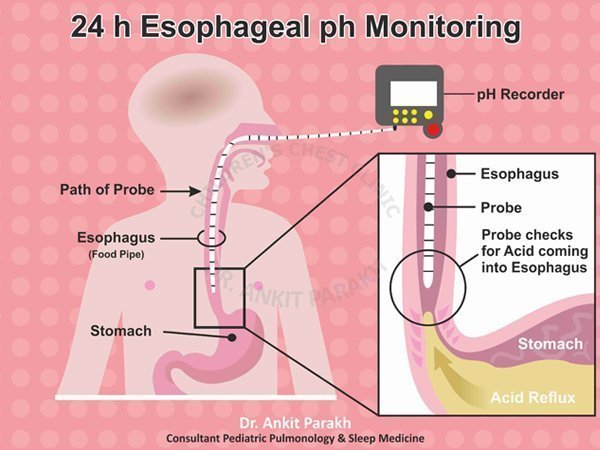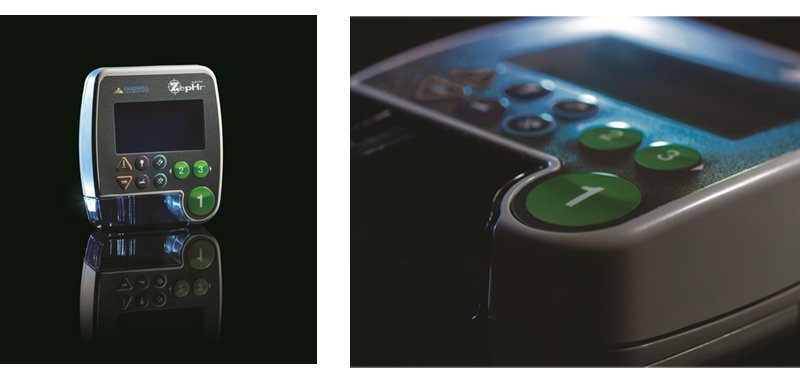
Studies for Gastro-Esophageal Reflux
Understanding the severity and impact of GER is essential for managing symptoms and preventing complications, such as esophagitis, respiratory issues, or poor growth. Investigations for gastroesophageal reflux disease (GERD) in children are helpful in GERD associated with respiratory problems or complications. This section deals with the common tests used are diagnosis of GERD in children: Reflux Scan (Radionuclide Scintigraphy) (also commonly called as Milk scan) and 24 hour esophgeal ph/impedance.
Gastroesophgeal Reflux and Gastroesophageal Reflux Disease
The esophagus also called as the food pipe is the tube that connects the mouth to the tummy/stomach. The valve at the bottom of the food pipe/esophagus (lower esophageal sphincter) opens up to let milk and food down and closes to stop acid from coming up. Gastroesophgeal Reflux or GER is the passage of gastric contents upwards into the esophagus or food pipe. This usually happens when this valve opens or closes at the wrong time. Few episodes of GER are common in infants and young babies (baby spits up or vomits) and usually doesn’t cause other symptoms.
When children have additional symptoms or complications it is called as gastroesophageal reflux disease or GERD. These symptoms could be refusing to eat or not gaining any weight, starting with vomiting at 6 months of age or older, fussy or having pain after eating etc. gastroesophageal reflux disease (GERD can also lead to respiratory problems like recurrent wheezing, frequent pneumonias, life threatening events also called as ALTE and recurrent apneas. Such situations demand testing for GERD.
Why Evaluate Gastroesophageal Reflux in Children?
Investigations for gastroesophageal reflux disease (GERD) in children might be helpful In the following ways:
- Respiratory manifestations (as mentioned above) when GERD is a differential diagnosis. Confirmation of diagnosis is essential for management.
- Identify complications like esophageal inflammation or aspiration.
- Respiratory manifestations (as mentioned above) when GERD is a differential diagnosis. Confirmation of diagnosis is essential for management.
Two most common tests used are scintigraphy and 24 hour esophgeal ph/impedance.
REFLUX SCAN (Radionuclide Scintigraphy) (also commonly called as Milk scan)
It is a non-invasive imaging test that assesses gastric emptying and detects reflux episodes. Reflux scan is very useful for identifying aspiration into the lungs and delayed gastric emptying.
To perform a scintigraphy milk, breast milk or formula is mixed with a small amount of "tracer" medicine. This "tracer" is a small amount of radioactive material. There are no side effects and the medicine will not change the taste of the milk. The scan begins while the baby is swallowing and will continue for approximately one hour. Your baby will lay on his back on the table with the gamma camera underneath. The gamma camera can image the movement of the milk with the tracer. In children with GER the tracer is seen to move up into the esophagus and can be seen coming upto the throat. In some children the tracer is seen aspirating into the airways and lungs.
24 hour esophgeal ph/impedance
A gold-standard test that measures the amount of reflux (both acidic and non-acidic) in the esophagus during a 24-hour period, and assesses whether your child’s symptoms are correlated with the reflux like coughing or irritability. Since this test measures both acid and non-acid reflux over 24 hours it provides a comprehensive evaluation of reflux events.
The 24 hour esophgeal ph/impedance test involves the placement of a probe through the nose of the child and place under xray guidance at the lower end of the esophagus as shown in the image. The probe is attached to a small ph/impedance recorder and kept for a 24 hour period. The probed identifies acid and non-acidic reflux episodes.

Evaluating Gastroesophageal Reflux (GERD) in children is essential for diagnosing and managing this common condition. Tests like the Refulx Scan and 24h pH/impedance study provide valuable insights into the severity and impact of reflux, enabling tailored treatment plans. If your child exhibits recurrent respiratory issues these can be secondary to Gastroesophageal Reflux (GERD). Consult a pediatric pulmonologist to explore the best diagnostic and management strategies.
Conclusion
Gastroesophageal Reflux Testing Services at BLK MAX Hospital
The facility for REFLUX SCAN (Radionuclide Scintigraphy) (also commonly called as Milk scan) and 24 hour esophgeal ph/impedance are available at BLK MAX Hospital, New Delhi.
Frequently Asked Questions (FAQs)
1. What symptoms indicate the need for reflux evaluation in children?
Frequent vomiting, irritability during feeding, poor weight gain, chronic cough, or recurrent respiratory infections may warrant evaluation.
2. Is the REFLUX SCAN safe for children?
Yes, the REFLUX SCAN is safe and involves minimal radiation exposure. It is a well-tolerated, non-invasive test.
3. What is the difference between a 24h pH study and esophageal impedance monitoring?
While a 24h pH study measures acid reflux, impedance monitoring detects both acid and non-acid reflux, providing a more comprehensive assessment.
4. Can the child feed during the 24h ph/impedence study?
Yes, child shall be able feed, talk, and breathe without any difficulty during the test.
5. What other investigations might be useful in the evaluation of gastroesophageal reflux (GERD) in children?
Upper Gastrointestinal (GI) Endoscopy allows direct visualization of the esophagus, stomach, and duodenum. It detects complications like esophagitis, strictures, or Barrett’s esophagus. Barium Swallow Study is a contrast imaging test that evaluates the anatomy of the esophagus and stomach. It is useful for identifying structural abnormalities like hiatal hernia but less sensitive for detecting reflux.



